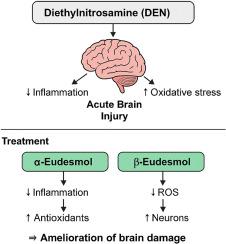α-苦叶酚和β-苦叶酚对二乙基亚硝胺所致急性脑损伤的改善作用
IF 2.4
4区 医学
Q2 PHARMACOLOGY & PHARMACY
引用次数: 0
摘要
二乙基亚硝胺(DEN)是一种广泛分布的环境污染物,对多种动物具有毒性和致癌性。本研究旨在探讨α-苦叶酚和β-苦叶酚对den所致大鼠脑损伤的神经保护作用。Sprague-Dawley大鼠腹腔注射单次DEN (200 mg/kg),然后静脉注射α-eudesmol或β-eudesmol (1 mg/kg),每周3次,连续21天。收集脑组织进行组织学、生化和免疫组织化学分析,包括脑损伤标志物(c-fos)和细胞凋亡标志物(caspase 3)。DEN暴露显著降低了抗氧化酶(过氧化氢酶、谷胱甘肽过氧化物酶和超氧化物歧化酶)活性,并增加了氧化应激标志物丙二醛。它还引发血小板活化、炎性细胞因子产生和脑组织病理改变,并伴有c-fos和caspase 3表达上调。α-eudesmol和β-eudesmol通过调节NF-κB/COX-2/TNF-α/IL-6信号通路,使多巴胺水平恢复到接近控制值,有效地减轻了这些变化。这些发现突出了α-桉树酚和β-桉树酚作为den诱导神经毒性治疗剂的潜力。本文章由计算机程序翻译,如有差异,请以英文原文为准。

Amelioration of diethylnitrosamine-induced acute brain injury by α-eudesmol and β-eudesmol
Diethylnitrosamine (DEN) is a widely distributed environmental pollutant known for its toxicity and carcinogenicity in various animal species. The aim of the study was to investigate the neuroprotective effects of α-eudesmol and β-eudesmol against DEN-induced brain damage in rats. Sprague-Dawley rats received a single intraperitoneal dose of DEN (200 mg/kg), followed by intravenous administration of α-eudesmol or β-eudesmol (1 mg/kg) three times weekly for 21 days. Brain tissues were collected for histological, biochemical, and immunohistochemical analyses, including markers of brain injury (c-fos) and apoptosis (caspase 3). DEN exposure significantly decreased antioxidant enzyme activities (catalase, glutathione peroxidase, and superoxide dismutase) and increased oxidative stress marker malondialdehyde. It also triggered platelet activation, inflammatory cytokine production, and pathological changes in brain tissue, accompanied by upregulated c-fos and caspase 3 expression. Treatment with α-eudesmol and β-eudesmol effectively mitigated these alterations by modulating the NF-κB/COX-2/TNF-α/IL-6 signaling pathways and restoring dopamine levels to near control values. These findings highlight the potential of α-eudesmol and β-eudesmol as therapeutic agents against DEN-induced neurotoxicity.
求助全文
通过发布文献求助,成功后即可免费获取论文全文。
去求助
来源期刊

Toxicon
医学-毒理学
CiteScore
4.80
自引率
10.70%
发文量
358
审稿时长
68 days
期刊介绍:
Toxicon has an open access mirror Toxicon: X, sharing the same aims and scope, editorial team, submission system and rigorous peer review. An introductory offer Toxicon: X - full waiver of the Open Access fee.
Toxicon''s "aims and scope" are to publish:
-articles containing the results of original research on problems related to toxins derived from animals, plants and microorganisms
-papers on novel findings related to the chemical, pharmacological, toxicological, and immunological properties of natural toxins
-molecular biological studies of toxins and other genes from poisonous and venomous organisms that advance understanding of the role or function of toxins
-clinical observations on poisoning and envenoming where a new therapeutic principle has been proposed or a decidedly superior clinical result has been obtained.
-material on the use of toxins as tools in studying biological processes and material on subjects related to venom and antivenom problems.
-articles on the translational application of toxins, for example as drugs and insecticides
-epidemiological studies on envenoming or poisoning, so long as they highlight a previously unrecognised medical problem or provide insight into the prevention or medical treatment of envenoming or poisoning. Retrospective surveys of hospital records, especially those lacking species identification, will not be considered for publication. Properly designed prospective community-based surveys are strongly encouraged.
-articles describing well-known activities of venoms, such as antibacterial, anticancer, and analgesic activities of arachnid venoms, without any attempt to define the mechanism of action or purify the active component, will not be considered for publication in Toxicon.
-review articles on problems related to toxinology.
To encourage the exchange of ideas, sections of the journal may be devoted to Short Communications, Letters to the Editor and activities of the affiliated societies.
 求助内容:
求助内容: 应助结果提醒方式:
应助结果提醒方式:


